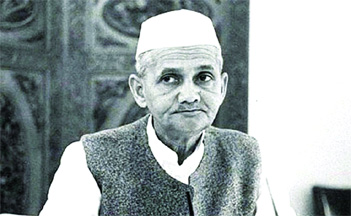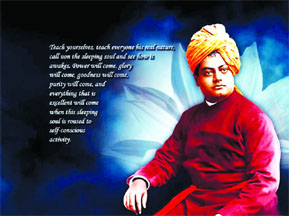
‘Jai Jawan, Jai Kisan’ – a phrase that resonates with every Indian, was coined by a man whose legacy continues to inspire us all — Lal Bahadur Shastri, a name synonymous with humility and dedication. Every year, on the 2nd of October, we come together to celebrate his birth anniversary, known as Lal Bahadur Shastri Jayanti.
In this article, you will learn a little more about his life, accomplishments, the profound impact he had on the nation and how his legacy continues to inspire generations.
Born on 2nd October 1904, Shastri Ji came from humble beginnings, deeply influenced by the values of honesty and hard work instilled by his mother, Ramdulari Devi, as his father, Sharada Prasad Srivastava, passed away only two years after Shastri Ji was born. He was born in the town of Mughalsarai, nestled within the Varanasi district of Uttar Pradesh, India.
His academic pursuits at Kashi Vidyapeeth earned him the title ‘Shastri’ in 1925, and he obtained degrees in philosophy and ethics, reflecting his commitment to intellectual growth.
Lal Bahadur Shastri’s Political Career
Shastri Ji’s political awakening was profoundly influenced by the likes of Mahatma Gandhi, Bal Gangadhar Tilak, Annie Besant, and other stalwarts of the freedom struggle. Their unwavering dedication to India’s cause inspired Shastri Ji to actively participate in the fight for independence. His deep admiration for Swami Vivekananda’s teachings further fueled his passion for nation-building.
In 1928, Shastri Ji joined the Indian National Congress, and two years later, in 1930, he took part in the historic Salt Satyagraha — a defining moment in the struggle for India’s freedom. His commitment to the cause saw him endure imprisonment several times, collectively amounting to seven years.
As India moved towards independence, Shastri Ji’s dedication and competence were recognised, leading to his appointment as a Cabinet Minister in the Nehru Ministry in 1952. He was entrusted with significant portfolios, including railways and transport. His tenure was marked by a strong sense of integrity.
However, in August 1956, a devastating railway accident struck Mahbubnagar, Andhra Pradesh, claiming the lives of over 100 people. Taking moral responsibility for the tragedy, Shastri Ji tendered his resignation to Prime Minister Jawaharlal Nehru. However, Nehru, recognising Lal Bahadur Shastri’s commitment and leadership, persuaded him to withdraw his resignation, believing in his ability to address the challenges that had arisen.
Tragically, just a few months later, in November 1956, another heart-wrenching railway accident occurred, this time in Ariyalur, Tamil Nadu, again, resulting in the loss of over 100 lives. Deeply affected by the recurring railway accidents and their devastating toll on human lives, Shastri Ji once again submitted his resignation to the Prime Minister. He pleaded for its early acceptance, emphasising the importance of accountability and responsibility in public service.
The second resignation, tendered by Lal Bahadur Shastri in the wake of the Ariyalur railway accident, garnered significant attention nationwide. The Pioneer, in its editorial on November 26, 1956, shortly after the Ariyalur tragedy, emphasised that while accidents could occur even in the best-regulated railways, they should be exceptions rather than the rule. The editorial did not place blame on the railway minister, recognising the complexity of the railway system’s operation and safety.
In his resignation letter, Shastri Ji expressed his belief that it would be beneficial for both him and the government if he quietly stepped down from the office he held. Notably, he used the word ‘quietly,’ underscoring his modest and unassuming nature.
Jawaharlal Nehru, addressing the dilemma he faced, acknowledged in the Lok Sabha that it was a difficult decision for him to accept Shastri Ji’s resignation. He went on to affirm his highest regard for Lal Bahadur Shastri and stressed the importance of setting an example of constitutional propriety.
Jawaharlal Nehru hinted that if he did accept the resignation, it would be based on the grounds of constitutional propriety. This aspect is noteworthy, as justifying the acceptance of the resignation on the principle of constitutional propriety faced significant scrutiny and criticism in the media.
This sequence of events reflects the depth of character and dedication to principles demonstrated by both Lal Bahadur Shastri and Jawaharlal Nehru during a critical juncture in India’s governance.
After India gained its hard-fought independence in 1947, Lal Bahadur Shastri continued his dedication to public service. He held various important positions in the Indian government, including the Minister of Police and Transport in Uttar Pradesh, which helped him understand the intricacies of governance.
In 1964, he ascended to the highest office in the country, becoming the Prime Minister of India, succeeding Jawaharlal Nehru. His leadership came at a crucial juncture in India’s history, marked by various challenges, including food scarcity and the looming threat of war with Pakistan. Shastri’s tenure was a testament to his unwavering commitment to the welfare of the nation and its people.
During his tenure, India faced one of its most challenging crises, the Indo-Pak War of 1965. Shastri Ji’s leadership during this period demonstrated his resolve and his dedication to peace.
His famous slogan, ‘Jai Jawan, Jai Kisan’ (Hail the Soldier, Hail the Farmer), captured the essence of his approach to the crisis. This slogan encapsulated the essence of his approach to the crisis and carried profound significance on multiple fronts.
– Honoring the Soldiers: ‘Jai Jawan’ hailed the soldiers on the front lines who displayed unwavering bravery and resilience in the face of adversity. It was an acknowledgement of their sacrifices and an expression of solidarity with those defending the nation’s borders.
– Recognising the Farmers: ‘Jai Kisan’ paid tribute to the farmers, emphasising the vital role they played in supporting the war effort. Shastri Ji recognised that self-sufficiency in food production was not only an economic necessity but also a strategic imperative during times of conflict. The slogan encouraged farmers to work tirelessly to ensure India had a steady supply of food.
– Unity and Resilience: Together, Jai Jawan Jai Kisan’ conveyed a powerful message of national unity and resilience. It underscored the idea that the entire nation stood as one, with soldiers and farmers working hand in hand to defend the country’s integrity and secure its future.
Lal Bahadur Shastri’s slogan not only boosted the morale of Indian soldiers but also inspired a sense of duty and patriotism among citizens from all walks of life. It highlighted the interdependence of security and sustenance, reinforcing the idea that a strong nation must be both well-defended and self-reliant.
In the midst of the conflict, Lal Bahadur Shastri’s leadership, encapsulated by this iconic slogan, steered India towards a position of strength and resilience.
Lal Bahadur Shastri’s death
Lal Bahadur Shastri’s passing remains shrouded in mystery and intrigue. On the night of January 11, 1966, while in Tashkent, Uzbekistan, for peace talks with Pakistan following the Indo-Pak War of 1965, the world was shocked to learn of his sudden demise. Shastri, then Prime Minister of India, had been engaged in intense negotiations with Pakistan’s President, Ayub Khan, to secure a lasting peace between the two nations.
The cause of his death was officially stated as a heart attack, but doubts and questions surrounding the circumstances persist to this day.
Despite the controversies surrounding his death, Lal Bahadur Shastri’s legacy endures as a symbol of unwavering commitment to the nation and its people. His sudden and untimely passing left the nation in mourning, and he was cremated with full state honours at Vijay Ghat in Delhi. Posthumously, he was awarded the Bharat Ratna in recognition of his exceptional service and leadership.





Be the first to comment